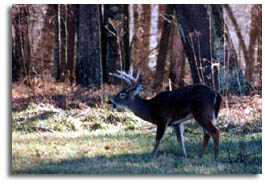| The Whitetail Deer is the most abundant deer species in North America.
Often adapts to living in close proximity to homes or business where nearby
woods provide cover or corridors to other areas. Often seen around edges of
agriculture fields and woods.
 Male Whitetail deer are called 'buck', females are called 'doe', and young
deer are 'fawns'. Usually a brown to red-brown in summer turning more tan in
the fall through the winter. This color change is possible because of the
deer's fur which is made up of thousands of hollow hairs. These hairs have
blood in them in the summer time which helps them stay cool and more
camouflaged with it's darker surroundings. In the winter time the hairs are
hollow giving the a layer of insulation from the cold of winter while changing
the deer's color to a gray to more closely resemble the color of the fallen
leaves and dead grasses. Male Whitetail deer are called 'buck', females are called 'doe', and young
deer are 'fawns'. Usually a brown to red-brown in summer turning more tan in
the fall through the winter. This color change is possible because of the
deer's fur which is made up of thousands of hollow hairs. These hairs have
blood in them in the summer time which helps them stay cool and more
camouflaged with it's darker surroundings. In the winter time the hairs are
hollow giving the a layer of insulation from the cold of winter while changing
the deer's color to a gray to more closely resemble the color of the fallen
leaves and dead grasses.
Male deer grow new antlers each year beginning about June. There antlers
usually consist of a main beam with additional tines growing up from the main
beam. Occasionally bucks grow what is called a non-typical rack where the
antlers grow in multiple or unusual angles and/or shapes. Bucks loose those
antlers each year usually beginning in late December but in southern states
they may keep them up through March. On very rare occasions whitetail does
have been known to grow antlers and males have been known to not grow antlers.
Often these animals are known to have been sterile
This picture was taken in Cades Cove in The Great Smoky Mountains National Park in Tennessee.
|